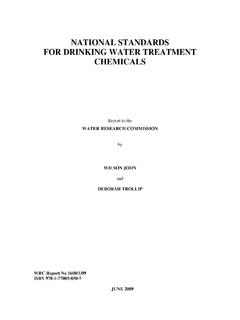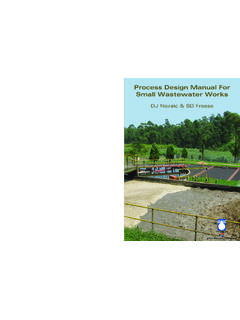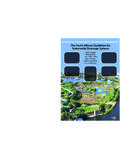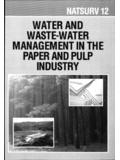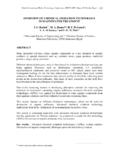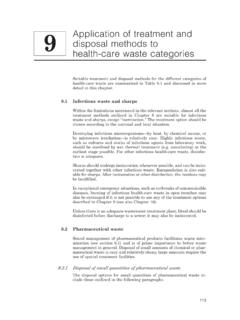Transcription of WASTEWATER TREATMENT TECHNOLOGIES – A BASIC …
1 1 WASTEWATER TREATMENT TECHNOLOGIES A BASIC GUIDEWRC Report No. TT 651/15 ISBN 978-1-4312-0725-12 Obtainable fromWater Research CommissionPrivate Bag X03 Gezina, or download from publication of this report emanates from a project entitled WASTEWATER TREATMENT TECHNOLOGIES A BASIC guide (WRC Project No. K8/1106).DISCLAIMERThis report has been reviewed by the Water Research Commission (WRC) and approved for publication. Approval does not signify that the contents necessarily reflect the views and policies of the WRC nor does mention of trade names or commercial products constitute endorsement or recommendation for use. Water Research Commission3 Sewers Industrial discharge Screening Grit removal Waste disposal options for screenings and grit Flow measurement Pond systems Wetlands Sedimentation Flotation Attached growth TREATMENT TECHNOLOGIES Suspended growth TREATMENT TECHNOLOGIES Nutrient removal activated sludge processes Other TREATMENT processes Constructed wetlands Ecosystem TECHNOLOGIES Chemical disinfection UV radiation Maturation ponds Thickening Stabilisation Dewatering 3 WASTEWATER TREATMENT TECHNOLOGIES A BASIC GUIDEI ndex41.
2 Introduction to the GuidelineThe National Water Act, 1998 (Act 36 of 1998) (NWA) states that sustainability and equity are central guiding principles in the protection, use, development, conservation, management and control of water resources. In essence the use of water and development aspects need to be managed or controlled in such a manner to protect and conserve water resources. WASTEWATER TREATMENT works (WWTW), more commonly referred to as sewage works, are just one of the many uses of water that are required when development takes place. In order to ensure that the development takes place in a manner that will be sustainable the WWTW chosen needs to be a technology type that will be suitable for a particular development and not necessarily the best available OF THE GUIDELINES everal Water Research Commission (WRC) reports have been compiled on WASTEWATER TREATMENT including: WASTEWATER Risk Abatement Plan - A W2 RAP Guideline Guidelines for the utilisation and disposal of WASTEWATER sludge Guidelines for the inspection of WASTEWATER TREATMENT works Guideline Document: Package plants for the TREATMENT of domestic WASTEWATER Sanitation design manual Energy Efficiency in the South African Water Industry; and Process design manual for small WASTEWATER worksThe need for a BASIC guide to serve as a quick reference document has been highlighted.
3 The purpose of the guide is therefore to graphically illustrate the journey of sewage from collection, conveyance, TREATMENT and discharge to the environment. The guide would include both the liquid and sludge this way its purpose is to enable those in decision-making positions, but who do not necessarily have a technical background, young engineers and inexperienced scientists who have just entered the field of WASTEWATER TREATMENT , to have a better understanding of the overall processes, terminology and reasons for WASTEWATER TREATMENT . In addition the tips in the guide around energy, legislative requirements and safety will help the reader ask relevant questions and make more informed decisions. WHO SHOULD USE THIS GUIDELINE? Decision-makers in a municipality who may not have a strong technical background however have to attend meetings and make decisions, including the Mayor and Councillors; and Young Engineers and Scientists who have just entered the field of WASTEWATER you know that discharge of WASTEWATER effluent to a water course or by irrigation is controlled by Government legislation, namely Chapter 4 of the National Water Act, 1998 (Act No.)
4 36 of 1998)?Do you know what type of authorisation your WWTW needs to apply for?5 Rural AreasAgriculturalCatchmentIndustrialUrba n AreasInformal AreasWWTPW ater TREATMENT PlantA WWTW must be authorised and the authorisation will specify the volumes of WASTEWATER effluent that can be irrigated to land, or discharged to a water resource daily, the volume being limited by the quality of the effluent and the impact on affected water resources, land, and health and safety of the RemovalScreeningsOxidation Ponds/WetlandsSedimentationFlotationTric klingFilterAnaerobicTreatmentNeutralisat ionEqualisationCoagulationAerated LagoonsPolishingTrickling FilterActivatedSludgeFiltration/Flotatio nOzonationGACA dsorptionPowderActivated CarbonDisinfectionNitrification/dentrifi cationDisinfectionPhosphorusRemovalDisin fectionCoagulantsConstructedWetlandsToRi verSludgeTreatmentAcid or alkaliIndustrialWastewaterSpill PondDomesticSewageCollection System (sewer)PRELIMINARY TREATMENTPRIMARYTREATMENTSECONDARYTREATM ENTTERTIARY TREATMENTToRiverToRiverToRiverToRiverChe micalsSludgeTreatmentChemicalsWastewater TECHNOLOGIES range from simple to complex systems.
5 It can incorporate some or a combination of TECHNOLOGIES indicated in this CAN YOU EXPECT TO FIND IN THIS guide ?The following two illustrations give a broad overview of: The type of technology that can be used at the different phases of the TREATMENT process train Technology option types related to population number served or environmental than 5000 peRange 5 000-50 000 peSuspended growthtreatment technologyAttached growth TREATMENT technologyyesnoStrict Nremoval requirement;TN < 20 mg/LNitrogen removalactivated sludgeprocessesyesPonds and wetlands technologyStrict Nremoval requirement;TN < 30 mg/LConventionaltrickling filtertechnologyHigh performancetrickling filterprocessesStrict Nremoval requirement;TN < 10 mg/LStrict Premoval requirement;P < mg/LStrict Premoval requirement;P < mg/LPonds with nitrifyingwetland and, orexternal nitrifyingtrickling filterStrict Nremoval requirement;TN < 20 mg/LHigh performancetrickling filterprocess with chemical P removalNitrogen andPhosphorus removalactivated sludgeprocessesnonoyesyesnonoyesnoyesyes yesyesyesA Larger contributing community will require a more sophisticated plantActivated sludge process required for TN < 10 mg/lHigh performance trickling filter with chemical phosphorusremoval to achieve 10 <TN <20 P <1 Additional considerations when choosing a technology option are:- skills requirements- land availability- ground conditions- sludge handling capabilities, and - cost (capital, O&M and life cycle)Note: Other factors such as capacity to manage the plant are critical82.
6 Collection SystemsPopulation and flow projections for areas served by a WWTW should be made before sizing of TREATMENT processes and piping. Where possible, designs should be based on a 10-year design period for any one phase of construction. However shorter periods or staged developments often need to be implemented to match predicted growth patterns. In considering staged development the ultimate development of the collection area should be assessed to determine how the layout for the plant may look if the area is fully developed. Consider water consumption data for an area, as at least 50-80% of the water consumed reaches the Sewers Sewers are the kilometres of pipes that are laid underground to collect sewage and greywater from households If citizens dispose of large items, or even newspapers, plastic and disposable nappies down the toilet, these can block the sewers causing overflows of sewage from manholes. This sewage then flows into the streets and can cause unpleasant odors and health impacts to the residents of that area The sewage that leaks from the manholes also flows down into the rivers and dams causing fish to die and algal blooms to form in dams These algal blooms can be toxic if ingested and add considerable costs to the TREATMENT of water for drinking Illegal sewer connections are mostly found in industrial areas where industries want to discharge illegally.
7 Industrial discharge Do you know which industries are discharging to your WWTW? Types of industries include: metal finishing industries, abattoirs, dairies, dry cleaners Does the effluent contain metals, fats or even sand as these are problem constituents faced by many WWTW process controllers? Do you know that metals collect in the sludge, making the sludge a hazardous material that can no longer be used?; Do you know that fats can clog the pumps and aerators at the WWTW adding considerable cost to the maintenance budget?; A plant that cannot operate effectively discharges poor quality effluent to the rivers or dams and can cause health impacts, fish deaths and even human fatalities, and add considerable cost to the TREATMENT of water for human consumption Do you have a pollution control function to monitor the above?; Do you have an awareness campaign for industries and citizens? Do you know how many people your WWTW will serve? Is it mainly residential, industrial or a holiday area?
8 A seasonal population may have considerable impact on the volume of sewage reaching the WWTW at different times of the year, so will you need to isolate (switch off) parts of a WWTW at certain times of the year? Do you measure your flows to the WWTW?Do you know that drinking water comes from the same dams that raw or poorly treated sewage flows into?99 WASTEWATER TREATMENT TECHNOLOGIES A BASIC GUIDE3. Preliminary ScreeningMaterials such as rags, plastic and foreign materials can significantly interfere with the TREATMENT processes or damage the plant equipment if not removed. These materials are removed by means of screening. The screened materials are hazardous and must be safely disposed of to prevent human health concerns, fly breeding and odours. Screens may be mechanical or manual. Manual screens: little or no equipment maintenanceand provide a good alternative for smaller plantswith few screenings but need to be cleaned moreregularly to prevent the build-up of debris; Mechanical screens: lower labour costs andimproved flow conditions and screening capture,however can have high equipment maintenancecosts.
9 Require constant energy Grit removalGrit material can include sand, silt, glass, small stones as well as other large-sized organic and inorganic substances (detritus). Excess grit can cause operational problems such as pump blockages and high organic concentrations in the digesters and/or reactors. Grit removal is therefore essential to protect moving mechanical equipment and pumps from is the reduction of solid materials from one average particle size to a smaller average particle size by crushing, grinding, cutting, vibrating, or other Waste disposal options for screenings and gritScreenings and grit left lying around will cause nuisance conditions such as odours and will encourage fly breeding. It should therefore be disposed of into a suitable container such as a large dustbin that can be closed. It is important to ensure that no screenings are left lying around on the ground. At small WWTW screenings and grit can be buried in trenches. These trenches must immediately be covered with soil once screenings and grit have been disposed you know that where larger volumes of screenings and grit are collected, legislation requires the screenings and grit to be disposed of to a permitted landfill site?
10 104. Primary Flow measurementChanges in the volumes entering the plant will alert the Process Controller to possible problems upstream of the works, a pump station failure. It is also important to know when the peak flow arrives at the WWTW. Flow is typically measured just after the screens and grit removal processes and it is important to note that one of the conditions of an authorisation will be that the flow is balancing, also called flow equalisation, is used to overcome the operational problems caused by flow rate variations and to improve the performance of the downstream unit processes. In other words, flow balancing is simply the damping of flow rate variations so that a constant or nearly constant flow rate can be tanks can be located before or after primary sedimentation. If placed after primary sedimentation, fewer problems with sludge and scum occur. If placed before primary sedimentation, mixing must be in place to prevent solids deposition and aeration may be needed to prevent Pond SystemsPond systems are simple, low maintenance systems requiring large footprint areas.
